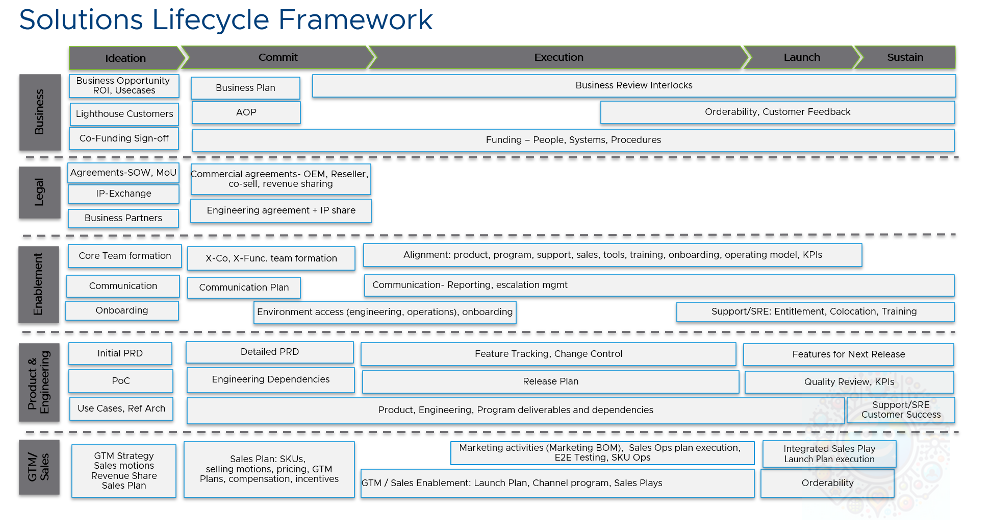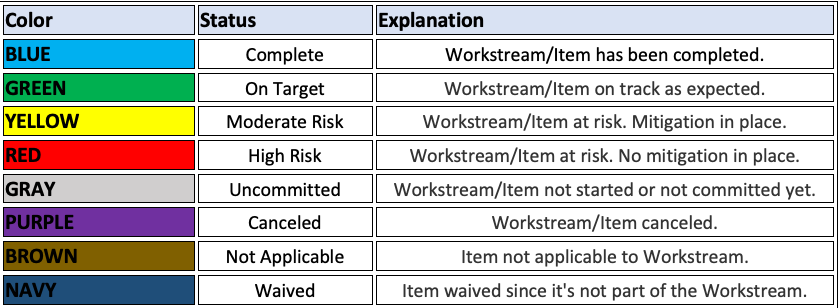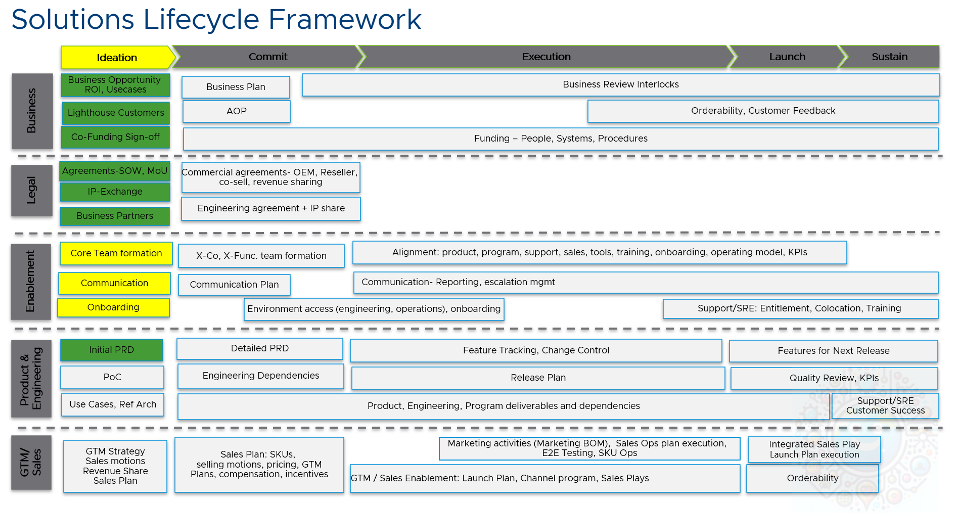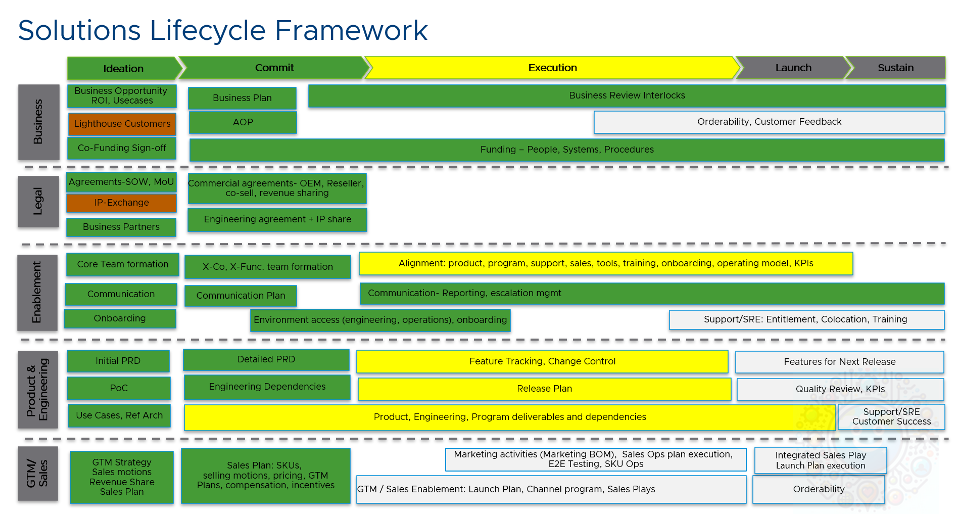Solution Lifecycle Framework: Navigating Success in Global Partnerships
A Comprehensive Guide to Collaborative Innovation at Scale
The Solution Lifecycle Framework: Navigating Success in Global Partnerships
In an era defined by rapid technological advancement and an ever-changing business landscape, it's critical for companies to innovate and collaborate effectively to stay competitive. I would like to share an operating model we developed in-house and have successfully applied to 80+ large cross-company and cross-functional initiatives -known as the Solution Lifecycle Framework (SLF). The SLF is a 5x5 matrix that serves as a guiding light for incubating new solutions. In this article, we will dive into the intricacies of the SLF, understanding its five stages on both the x and y axes and dissecting what happens at each stage. Through this exploration, we will unveil how the SLF can be utilized to establish governance, accountability, clear taxonomy, strategic and tactical alignment to help you deliver.
Lifecycle of any joint collaborative initiative may include the following areas:
Joint business opportunity
Joint feasibility studies
Cross-company legal agreements
Joint Go-To-Market strategy
Joint sales motions
Joint sales enablement
Joint sales readiness
Cross-company engineering and integration enablement
Cross-company communication
Cross-company Governance
Tooling to enable collaboration
Cross-company KPIs
Joint SRE strategy when applicable
Joint customer support strategy and enablement
The SLF: A Comprehensive Overview
The Solution Lifecycle Framework (SLF) is a meticulously designed 5x5 matrix, providing a high-level framework for incubating new solutions in collaboration with global partners. It comprises two dimensions: the x-axis, representing five distinct Phases, and the y-axis, representing five critical Domains. Let's break down each dimension.
The above shows a blank SLF template with no color-coding
X-axis: The Phases
Ideation
Commit
Execution
Launch
Sustain
Y-axis: The Domains
Business
Legal
Enablement
Product & Engineering
GTM/Sales
Let's explore the key areas covered at each stage:
Phase 1: Ideation Phase
In the Ideation phase, the primary focus is on generating innovative ideas and exploring the potential of new solutions in collaboration with partners. Here's what happens in each domain:
Business Domain: Identify market opportunities, assess potential risks, potential funding requirements, and create a comprehensive business plan. Determine key partners, cross-company decision-makers, and lighthouse/early customers.
Legal Domain: Legal teams across participating companies work to establish the foundational agreements necessary for the project, covering areas like intellectual property rights, contractual terms, and other legal considerations required for collaboration.
Enablement Domain: Enablement efforts begin with identifying core teams, tools, and processes that will support the project. KPIs are established, and communication plans are developed to ensure transparency and accountability.
Product & Engineering Domain: Detailed requirements are gathered, and the project's technical feasibility is assessed. Solutions are researched and ranked, and funding proposals are prepared. The groundwork for cross-company collaboration is established.
GTM/Sales Domain: Initial GTM strategies and sales plans are outlined during this stage. Pricing, packaging, and commercial agreements are also part of the plan. High-level sales strategies and marketing plans are developed to align with the project's goals.
Phase 2: Commit Phase
In the Commit phase, the focus shifts to securing resources, establishing formal agreements, and preparing for the execution of the project. Here's what happens in each domain:
Business Domain: Financial planning and budgeting become central as teams work to secure the necessary resources for the project.
Legal Domain: Legal teams play a crucial role in finalizing engineering and commercial agreements, ensuring that all legal aspects of the project are in order.
Enablement Domain: Enablement efforts aim to identify essential tools, processes, and KPIs to support the project's execution. Core teams are formed to manage accountability and progress. Joint forums are established for cross-company/ cross-functional teams to communicate and onboard people as needed to collaborate on the project.
Product & Engineering Domain: Detailed requirements are locked down, and the project moves towards a top-down approval process. The focus is on formalizing product development and engineering plans.
GTM/Sales Domain: In this domain, formal GTM strategies, including pricing, sales motions, and marketing plans, are refined. Commercial agreements are signed, and geographical targets and routes to market are established.
Phase 3: Execution Phase
The Execution phase is where the project comes to life, and all the planning and groundwork from previous phases are put into action. Here's what happens in each domain:
Business Domain: Execution in the business domain involves allocating and managing resources, orderability, overseeing the project, utilizing lighthouse customer feedback, and addressing any escalations or issues that may arise.
Legal Domain: Legal teams stay involved mostly in monitoring mode, ensuring that all parties adhere to previously established agreements. They may need to intervene if there are discrepancies, resource and funding issues, or regulatory challenges.
Enablement Domain: This phase provides transparency, visibility, and accountability for the intended solution. Metrics play a crucial role in understanding and addressing the health of the solution, and regular reporting keeps stakeholders informed.
Product & Engineering Domain: This domain is responsible for executing detailed product development plans, tracking progress, and ensuring that all technical aspects are on track.
GTM/Sales Domain: Execution in this domain involves implementing sales operations plans, conducting end-to-end testing, launching sales plays, delivering pre-GA sales training, and executing marketing plans.
Phase 4: Launch Phase
The Launch phase signifies the culmination of efforts and the transition to market readiness. Here's what happens in each domain:
Business Domain: Teams ensure that the project is orderable and track progress during regular meetings. Integrated sales play execution, support team training, and collecting early-stage customer feedback are essential activities.
Legal Domain: Legal teams continue to play a role in ensuring that all legal aspects are in order, especially as the project moves into the market.
Enablement Domain: The focus is on ensuring alignment across all functions, clarity, transparency, and accountability to ensure timely release. Ensuring fully trained Support and sales teams at this stage is critical to the success.
Product & Engineering Domain: The project enters the final stages of development, with quality reviews initiated to ensure that the solution meets the required standards.
GTM/Sales Domain: Sales operations are in full swing, with marketing efforts executed to promote the solution in the market.
Phase 5: Sustain Phase
In the Sustain phase, the project has matured, and long-term considerations come into play. Here's what happens in each domain:
Business Domain: Teams agree on the next feature set and milestones to continue enhancing the solution. In some cases, End-of-support (EOS) and end-of-life (EOL) planning are also discussed.
Legal Domain: Legal teams work on messaging alignment across companies and joint messaging to inform and manage customer expectations. They may also be involved in writing EOS knowledge base articles and coordinating EOL plans.
Enablement Domain: The focus is on maintaining transparency and accountability as the solution continues to evolve. Post-mortem evaluations are conducted, and feedback is documented for future improvements. Manage cross-functional transitions that may occur during this phase.
Product & Engineering Domain: Teams work on aligning the next feature set and milestones, ensuring that the solution remains competitive and meets evolving customer needs.
GTM/Sales Domain: Ongoing sales, marketing, and customer support activities are critical for sustaining the solution's success in the market.
Utilizing the SLF as a Heatmap
The SLF's power lies in its ability to serve as a heatmap, visually representing the progress of a project. Each cell in the 5x5 matrix can be color-coded to indicate the status of specific aspects of the solution. This visual representation aids in tracking the evolution of the project across various stages and domains.
Demonstration
Here are examples of projects in various Phases demonstrating how to utilize SLF as a heatmap:
Example 1: Project is in Ideation Phase and tracking Yellow due to Enablement issues.
Example 2: Project is in Execution Phase and tracking Yellow due to cross-functional Alignment issues.
Summary
The Solution Lifecycle Framework (SLF) offers a structured approach to managing projects in collaboration with global partners. Organizations can navigate complex collaborations with clarity and success by understanding what happens in each stage within the five domains. Whether in the Ideation, Commit, Execution, Launch, or Sustain phase, the SLF provides a roadmap for innovation, efficient execution, and long-term sustainability in today's interconnected business landscape. Embracing the SLF is not just a strategic choice; it's a commitment to excellence and sustainable growth.





